Nokia Lumia 930 Review
by Brett Howse on September 8, 2014 3:00 PM EST- Posted in
- Smartphones
- Microsoft
- Nokia
- Mobile
- windows phone
- Lumia
Battery Life
For the battery life tests, we have a standard workload that the phone performs while connected over Wi-Fi, or Cellular data. The display is calibrated at 200 nits for consistent comparison data for the charts. The device is run under this standard load until it shuts down.
Windows Phone has a battery saver mode, so these tests were done twice. Once with battery saver disabled, and another with it enabled which stops all background events from being run.
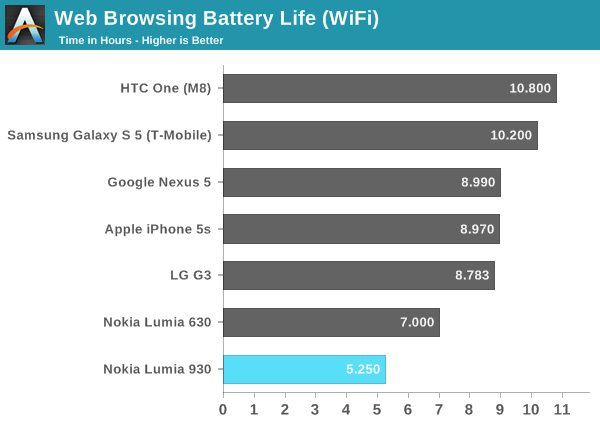
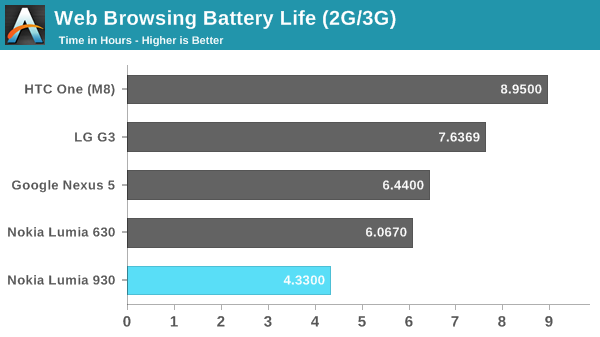
The Lumia 930 has an integrated 2420 mAh 3.8 V battery, for a total of 9.2 Wh. This is quite a bit smaller than the battery in the Galaxy S5, which has the same screen size and also has a removable battery. Unfortunately the Lumia 930 is one of the worst performers in battery life in a long time, with just over five hours of Wi-Fi battery life. The phone gets very warm during these tests. The AMOLED display in this phone seems to draw an exorbitant amount of power when displaying the mostly white content of our web browsing tests. I was unable to test over LTE due to the model of 930 that was shipped to me for review not supporting any of the LTE bands in my area, but over HSPA the result is unsurprisingly even worse than Wi-Fi, with only 4:20 of runtime.
Windows Phone also includes a Battery Saver feature, which disables most background tasks from being able to function unless you have specifically allowed them. Email, as an example, must be manually synchronized rather than having push support. With the Lumia 630 this dramatically increased the runtime of the phone.

As we saw with the Lumia 630, Battery Saver has a significant impact on battery life. However, we simply go from terrible to bad. The Lumia 630, with a smaller battery, does significantly better with its low resolution LCD display in this test.
Another battery test we can perform is by using BaseMark OS II, which contains a battery life test. This eliminates us depending on the javascript engine as part of our test.
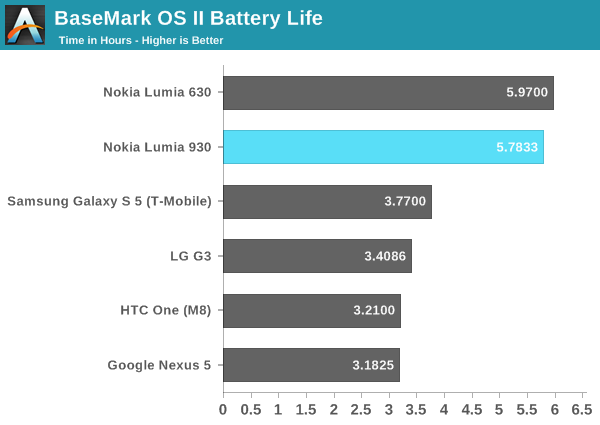
The Lumia 930 almost completely flips the table here.In fact, the native benchmark even surpasses the Wi-Fi web browsing test.
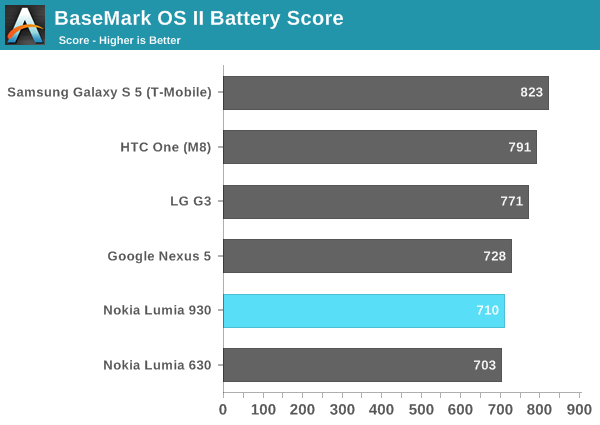
On the battery score for the Basemark test, the Lumia 930 does not do as well as the high runtime would suggest, falling behind other devices once again, but in this test, it is much closer than the web browsing test.
Charging
The Lumia 930, with the latest version of Windows Phone, supports Qualcomm’s Quick Charge 2.0 specification which allows a higher voltage charger to be used for much faster charging. The 930 also supports built in Qi wireless charging.
The 930 which was sent for this review came with an EU wall plug, which is obviously incompatible with North American electrical outlets. The charger shipped with the unit supports up to 1.5 A at 5 V, but the highest amperage charger available to me was a 1 A version which I used for these tests. Expect better results if using the 1.5 A version, or especially if you have a Quick Charge 2.0 capable charger.
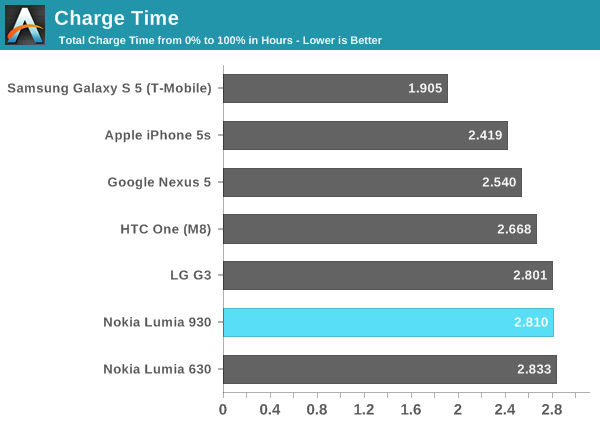
At almost three hours, this is a bit high, but with the correct charger this should be closer to the 2.5 hour mark, if not under.
Battery Conclusion
With a smaller battery than other devices of a similar size, it is not surprising that the Lumia 930 can not keep up with the competition, but it was surprising just how poorly it fares in the web browsing tests. The phone would get noticably warm during the web browsing test.
As Anand found during his review of the Samsung Galaxy Tab S, AMOLED devices can suffer in the web browsing tests due to the mostly white backgrounds, but they can excel at video, and the Lumia 930 follows in the same direction, but white backgrounds put a major strain on the battery of this device. Still, the newer generation AMOLED in the Galaxy S5 could last 10 hours with its 10.78 Wh battery.
The Lumia 930 is not a small phone. In fact, with the straight sides, the Lumia 930 has quite a bit of volume to it. One of the tradeoffs of sealed battery phones like the Lumia 930 is that you should be able to fit more battery into the device because you don't have to worry about the shape of the battery, or have a plastic case around the battery for an end user to handle. The Lumia 930 does not follow with this logic. It is difficult to comprehend how a phone this size can not have a larger battery in it.
That being said, real world battery life was never a big issue for me during my time with the phone. The battery saver app will give you an estimate as to how much time is remaining before the device needs to be charged, and it always showed well over a day. Many of the Windows Phone hubs and apps have black backgrounds, which can dramatically increase the battery life of AMOLED devices which also contributes. Still, with the progress on battery life in the last several generations of phones, one would expect more.










115 Comments
View All Comments
milroy - Tuesday, September 9, 2014 - link
"The power button placement is certainly in the right location when compared to a phone with the power button on the top which gets awkward to use especially on a larger phone such as this."This is actually one of my main gripes with Lumia designs. The power button is so easy to access it is difficult to grip the phone without accidentally activating it. I have inadvertently turned my phone off countless times. With the current design you have to be very careful how you hold it by the sides Otherwise you need to hold it glass to back.
I’ve had the 925 and now the 1520 and both have been excellent.
siberstorm - Tuesday, September 9, 2014 - link
It would be great if you added some sort of camera consistency benchmark for future reviews. It's something most reviewers don't do. Actually I don't think I've ever seen it before. Take a dozen pictures of the same scene back to back. Mark off the ones that you consider "good" and give the percentage. Also do the same test when changing scenes quickly. The biggest reason why people like the iPhone's camera is because of its consistency. Nokia's camera's are technically better, but most people aren't looking for max potential. They want the first shot to be the only shot. This is also a problem for camera's that use their inbuilt OIS too liberally. The shutter speed is too slow and a moving subject, which is often the case, will just end up a blur. A noisy shot is much better than a smeared blurry shot.croc123 - Tuesday, September 9, 2014 - link
The more I read about the newer phones with good-ish cameras, the more I am tempted to get a new Nokia 808... While I still can. (Maybe two.)saliti - Tuesday, September 9, 2014 - link
The battery life test of Anandtech is horrible and not representative of real life battery life. I don't even use it as reference. GSMArena's battery life test is more balanced.leopard_jumps - Tuesday, September 9, 2014 - link
Shoot a video with passing cars (i.e. fast moving objects) , go to some flowers , buildings . We need to know the quality of the video abilities .boostern - Tuesday, September 9, 2014 - link
Sorry but this is one of the worst review ever made on anandtech.I really hope that is not the course that anandtech will take with the departure of Anand, because even a week ago a page like that of WiFi tests would be never been published.
boostern - Tuesday, September 9, 2014 - link
The more I read this review the more i found it flawed.Even in the battery life pace I see flaws, the subjective comments at the end where you say that in your tipical day the battery life was OK, what does it mean? How is your tipical day? What kind of activities you do in your tipical day?
Finally, there is too few data in this review compared to the Anandtech's standard...and too few comments on data outcomings.
Brett I don't want to attack you, but please read carefully one of the review made by Anand, Brian or even Joshua...
Brett Howse - Tuesday, September 9, 2014 - link
Hi Boostern,First off, I don't take it as an attack. Our readers demand a high level from us which is fantastic. If we don't meet that then we need to get better. Let me address a couple of your points:
The Wi-Fi was clearly a mistake. Without an ac router (which I am working on obtaining now) my options were test 802.11n, or not test. I chose to test n because I'd say the vast majority of people have n anyway, so they aren't going to see the huge speeds from ac. Clearly that was an error, and may people have pointed it out. In the future, I'll likely do both n and ac testing.
As for the battery life, our battery life test is really a worst case for this phone. I had to make the point that even though in the chart it shows < 6 hours, the average person on an average day is not going to need to charge the phone in 6 hours. The white backgrounds really hurt this AMOLED generation. My typical day and your typical day are not the same of course, which is why we can't test a "typical day". Perhaps we can look at doing some sort of different battery life testing and it is something we can discuss internally.
Also, not all of the benchmarking tools we use on other platforms are available on Windows Phone. It's just a reality of 3.5% market share and two dominant players in front. We are working on our own tools, but they take time and they are not available yet.
As for the comments on data, Anand had 17 years of experience and this is my second phone review, so I'll try better next time.
Thanks for reading - we all do appreciate the readers of the site. We know you expect the best and if we don't deliver it, then you have the right to ask for better.
boostern - Tuesday, September 9, 2014 - link
Thank you for the response.Regarding the battery life page in the article, I think you should also take into account the differences in Snap 800 vs Snap 801 and the inherently power differences of these two SoCs. If you compare the 930 with other phones you should also explain the differences in the results, the majority of phones you compare against the 930 are based on Snap 801 platform that brings some optimizations in power comsumption. Nonetheless you should also compare the 930 with phones based on the same platform (for example the Nexus 5) and point out that the optimization job done made by Nokia was bad and is not the state of the art. The bad result are not only due to the display adopted (surely this is a reason), but also these results comes from the adoption of the Snap 800 and the not so good job in the optimization. Another advice: are the good result obtained in Basemark battery life a result of the worse performance obtained in this test VS the competitors? As Anand and Brian showed us in the recently past this could be an explanation of the results, in that the CPU stays in lower states for a longer amount of time. Take it only as an advice ;)
snoozemode - Tuesday, September 9, 2014 - link
Also, why not use a EU -> US wall plug converter so that you could use the included 1.5A charger? Now the battery charging time is irrelevant.